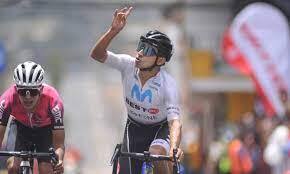

A sudden crescendo of controversy has yet again surpassed the hum of wheels and the asphalt tracks and seeped into the world of professional cycling. The twist of events has cast a shadow on the Columbian cycling scene, with the 29-year-old cyclist Marco Tulio Suesca facing suspension over a positive test for EPO.
The out-of-competition screening took place in September, and the anti-doping authorities are awaiting the analysis of the B-samples. The recent victories of Suesca have been undermined under the pressure of a potential doping scandal that added a layer of complexity, questioning the integrity required in the world of competitive cycling.
ADVERTISEMENT
Article continues below this ad
Suesca tests positive and undergoes temporary suspension
Being an integral part of the Movistar-Best PC team, starting from the stage victory in the Vuelta de Boyaća making his way to securing triumph in Vuelta al Ecuador, Suesca maintained a consistent performance. Grabbing a series of wins in the previous year, including a victory in the Vuelta a Costa Rica and finishing fifth place in Vuelta a Colombia, Suesca ensured to secure his position as a rising star within the South and Central American circuit.
Based on the reports of Cycling Up to Date, his dedication to cycling landed him in the third position, just behind the strong cycling duo, Lopez and Sevilla, during the Vuelta Bantrab. However, despite being at the peak of his professional career, Suesca has been provisionally suspended as per the Colombian anti-doping tribunal.
The cyclist will be staying away from the world of cycling as the doping authorities await the analysis of the B-sample. With this doping incident, the cycling community has found itself grappling with the dilemma of supporting Suesca in his best form.
ADVERTISEMENT
Article continues below this ad
The ongoing battle of the cycling sport against doping
Even though it has been revealed that Suesca tested positive for EPO before the beginning of the Vuelta de Boyaća, it has raised concerns questioning the gaps in scrutinization existing within the cycling community. The anti-doping measures have been put at stake, revealing the challenges that officials have to undergo to preserve integrity within the sport.
However, Suesca is not the first cycling to be involved in a case of doping controversy revolving around Columbian cycling. This year, on August 17, another renowned Columbian athlete, Nairo Quintana, was disqualified from the 6th place finish in the Tour de France after testing positive for Tramadol. Starting from March 1, 2019, the use of tramadol has been banned by the UCI Medical Regulations, while WADA added it to the list of prohibited substances effective from January 1, 2024.
ADVERTISEMENT
Article continues below this ad
The cycling community awaits further analysis and a final ruling that will decide Marco Tulio Suesca’s cycling journey. No matter the outcome, the decision to keep the cyclist’s participation on hold for the moment, irrespective of his achievements, had a positive impact on the credibility of competitive cycling.
Watch This Story: “That Is How You Inspire the Next Generation” – Unexpected Souvenir From a Pro Cyclist at a Jumbo-Visma Team Race Makes a Young Fan’s Day
ADVERTISEMENT
ADVERTISEMENT
ADVERTISEMENT
ADVERTISEMENT

